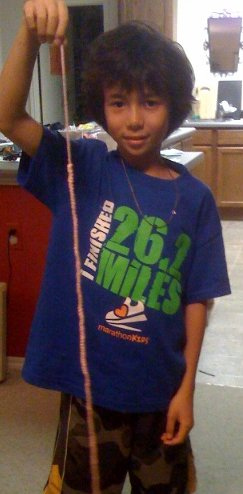When I wrote my previous post, I didn’t know I’d soon have a perfect illustration of what learning looks like for younger students who have a natural joy for learning.
In The Passionate Learner, Robert L. Fried points out that in preschool or kindergarten learners: “Curiosity is everywhere. Questions abound. Pride and delight in learning are everyday occurrences. The children draw and paint seemingly without inhibition. . . . They wonder constantly about why things are the way they are.”
I had the opportunity to babysit my nephews, one in preschool, the other in elementary school, last night. Upon arriving, I noticed my older nephew was sitting on the couch with some yarn, quickly weaving it together. He was delighted to show me a basket that he had braided the yarn for and then woven together. By the time we finished talking about it, he had woven another long strand together which he was eager to show me.
Meanwhile, my younger nephew pulled us out to the driveway and street, to show us his latest handiwork. While he was outside, through some inspiration that we will never know(he’s 3), he had used his Easter chalk and written a trail of letters that spilled out of the driveway, and wound across the asphalt for quite a ways. He proudly showed us and then carefully proceeded to read each of the 100 or so letters that he had drawn on his letter pathway.
Neither of the boys had been given an assignment to do this “work”, though they were using skills they were learning in school. They had just taken what they were learning, applied their own creativity and passion for it, and created these wonderfully spontaneous works both out of their own desire to do it, and out of a desire to share. As my younger nephew said, “I did this for all of you.”
This kind of spontaneous pursuit of something is what passionate learning is all about. This is what it often looks like in younger children.
So I have a question for those of us who have older children or work with older children–do we really stop, take the time to look at each creation they have made, and enjoy their pride in its creation?
But my other question is, do we leave time in their day for play? When I am overharried, tired, overworked–do I stop to just wander and smell the roses? Not often. The same goes for our students–in this era of accountability, and piles of homework, and increasing pressure on college applications, testing, and the like–do our students even remember/know how to play and to create, just because they “want to?” Do we ever give them time to do that or encourage their creative pursuits?
Does the mass of students we face at the secondary level (150 a day or so…) impinge on our ability to do this with them? How do we find ways to engage with them, celebrate successes with them, and tap into their passions? It seems more personalized learning is a portion of that, rather than generically sending out the same content to all our learners, as though they are vessels.
There is so much creative energy to tap into here for educators, and it would add so much to our work with students to tap into it. Technology is one pathway to that–because many tools allow for student creativity and diversity, but of course there are many non-technology related pathways to that too.
In The Passionate Learner, Fried writes about entryways into more passionate learning with students–(ways like having a day where students share “what I learn outside of school,” for example). But he emphasizes that most importantly classrooms where students learn best seem built not around curriculum, but about a trusting and positive relationship with the teacher, a teacher who doesn’t view the students as buckets to be filled generically, but as students who are personal to them. I know so many excellent teachers who feel this way about their students, and yet struggle with the balance between curriculum, AP courses, and the students as people. Fried believes this balance is very important. The value of students seeing us as individuals is also important to that balance–to see that we learn and play as well.
Fried encourages us to view curriculum as a function of relationships:
“When we view curriculum as a function of relationships, we bring it to our classrooms and lay it out, like a comfortable and useful garment. We allow ourselves and our students to make it belong to us, to adjust it, to restyle it, to enliven it, to infuse it with meaning. Such ownership increases the likelihood that young people will approach the knowledge and skills to be learned as active, critical, thoughtful investigators, rather than as passive receptors (or rejecters).”
When we invite our students in to our curriculum, how does that change things? Are any of you doing that in your classrooms and what does that look like? And how do we also invite our students’ passions in to our own classroom?
Because ultimately, don’t we want our students to rush home and begin weaving their own threads of meaning?

